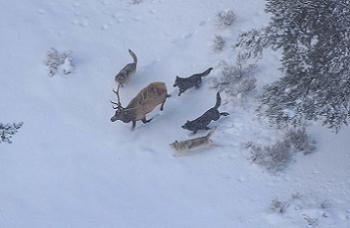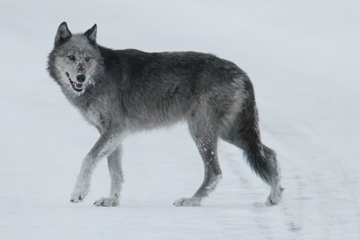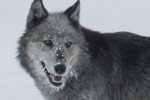A ‘rider’ attached to the most recent budget passed this week in the US congress has stripped gray wolves from the protection of the Endangered Species Act, a first in the law’s nearly 40-year-history.
The rider, which was signed into law under the budget on Friday by US President Barack Obama, hands gray wolves (Canis lupus) in Montana, Idaho, Utah, Washington, and Oregon from Federal protection to state control. Hunting is expected to begin soon.
“Unmanaged wolves have destroyed jobs, rural economies, and the opportunity for people to put food on their plate,” Don Peay, founder of Sportsmen for Fish and Wildlife, told the BBC.
 Wolves chasing an elk in Yellowstone National Park. Photo courtesy of the National Park Service. |
Wolves are hugely controversial in the region: ranchers point to them as a cause for cattle mortalities, while hunters blame them for a decline in elk. Although researchers say the elk decline may be due to a combination of drought, hunting by people, and the return of wolves.
With the legislation conservationists are especially concerned that it will set a new precedent for congress removing controversial species from the Endangered Species Act.
“Congressional delisting without the opportunity to restore protections threatens to bring us back to the days when wolves and other wildlife were systematically poisoned on public lands,” Kierán Suckling, executive director of the Center for Biological Diversity, said in a press statement. “We ask President Obama to veto the federal budget to ensure that an endangered species is not massacred; that the Endangered Species Act is not gutted; and that the science, not politics, determines which species benefit from federal protections.”
Wolves have only recently crossed state lines into Oregon and Washington, but environmentalists fear hunters will quickly wipe out these emigrant populations.
 A wolf in Yellowstone National Park. Photo courtesy of Yellowstone National Park. |
The return of wolves to the US West, which began with a few wolves crossing down from Canada into Montana while dozens were reintroduced by the government, has allowed researchers the rare opportunity to study how an ecosystem changes when its top predator returns.
Biologists discovered that elk, propelled by fear, moved away from many of their preferred grazing grounds. The lack of constant grazing allowed long dormant aspen stands to return; biodiversity increased; and ecosystems, such as streams and rivers, became healthier.
“It is clear and profound. The wolves leave an indelible mark on the entire ecosystem,” Cristine Eisenberg with Oregon State University told the Missoulian in 2009.
According to Eisenberg wolves aren’t killing all of the elk, but have caused the herd animals to revert to more natural behavior.
“[Wolves] have totally changed [the elk’s] behavior. For 60 years we’ve become used to complacent elk. These elk aren’t complacent. They’re on high alert,” said Eisenberg.
Researchers estimate that around 1,600 wolves survive now in the Rocky Mountain States. However, although many in the area have complained that wolves are overabundant, the state of Minnesota in the US Midwest contains nearly 3,000 wolves in its northern half alone.
Minnesota, Wisconsin, and Michigan are currently considering removing their wolf populations from the Endangered Species Act. But these states are pursuing the prescribed channels to de-list the wolf, not new legislation.
Related articles
What do wolves and sharks have in common?
 (11/15/2010) Sharks dwell in the ocean, wolves on land; sharks are a type of fish, wolves are a mammal; sharks go back some 400 million years, wolves only some 2 million years. So, these animals should have little in common, right? However, a new study in Frontiers in Ecology and the Environment points to surprising similarities among these disparate animals. As top predators, both wolves and sharks impact their prey and other species in similar ways.
(11/15/2010) Sharks dwell in the ocean, wolves on land; sharks are a type of fish, wolves are a mammal; sharks go back some 400 million years, wolves only some 2 million years. So, these animals should have little in common, right? However, a new study in Frontiers in Ecology and the Environment points to surprising similarities among these disparate animals. As top predators, both wolves and sharks impact their prey and other species in similar ways.
Why top predators matter: an in-depth look at new research

Wolves keep forests nutrient-rich
(11/02/2009) As hunting wolves is legal again in two American states, Montana and Idaho, researchers have discovered an important role these large predators play in creating nutrient hotspots in northern forest environments. Researchers from Michigan Technological University found that when wolves take down their prey—in this case moose—they do more than simply keep a check on herbivore populations. The corpses of wolf-hunted moose create hotspots of forest fertility by enriching the soil with biochemicals. Due to this sudden up-tick in nutrients, microbial and fungal growth explodes, in turn providing extra nutrients for plants near the kill.